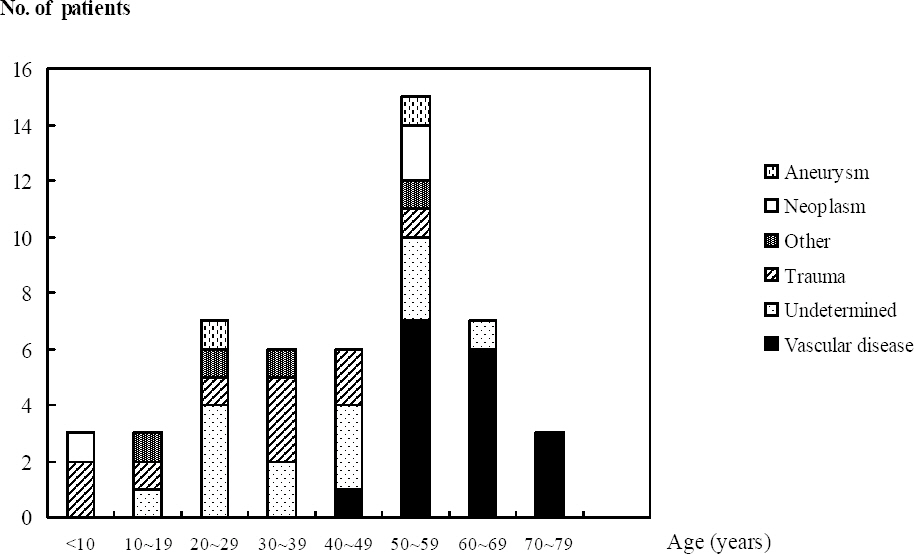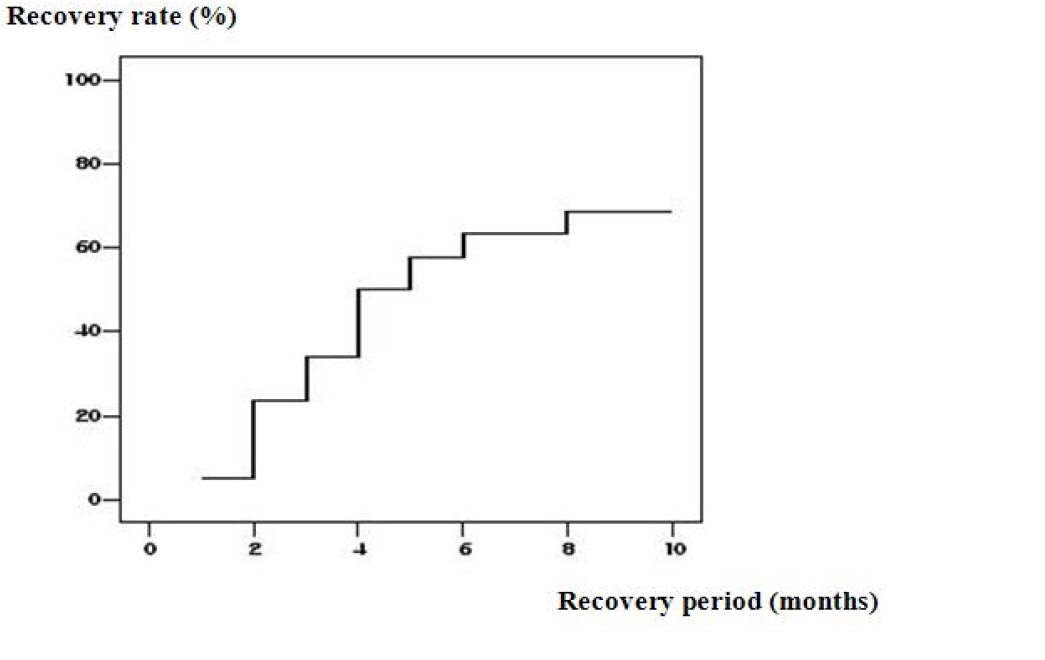J Korean Ophthalmol Soc.
2008 Aug;49(8):1323-1329. 10.3341/jkos.2008.49.8.1323.
Clinical Features of the Sixth Cranial Nerve Palsy
- Affiliations
-
- 1Department of Ophthalmology, School of Medicine, Ewha Womans University, Seoul, Korea. Limkh@ewha.ac.kr
- KMID: 2211739
- DOI: http://doi.org/10.3341/jkos.2008.49.8.1323
Abstract
- PURPOSE
To evaluate the clinical features and natural course of sixth cranial nerve palsy.
METHODS
We reviewed the medical records of 50 patients who were diagnosed with sixth nerve palsy from January 2000 to December 2006 to analyze the age of onset, etiology, recovery, and natural course of this disease.
RESULTS
The mean age at onset was 43.2 years old. Vascular disease (n=17, 34.0%) was the most common cause of sixth cranial nerve palsy, followed by undetermined causes (n=14, 28.0%), trauma (n=10, 20.0%), and neoplasm (n=3, 6.0%). According to age group, vascular disease (n=7, 46.7%) was the most common cause in patients in their fifties and sixties, and trauma and undetermined causes (n=10, 76.9%) were the most common causes of this disease in patients in their twenties and thirties. Of the 40 patients who were followed up for more than 6 months, 28 (70.0%) showed improvement of paresis and 26 (65.0%) achieved complete recovery. The mean period to recovery was 3.7 months. No significant differences were observed in sex, age, laterality, and etiology between non-recovered and completely-recovered patients, but completely-recovered patients showed a significantly smaller initial angle of deviation than non-recovered patients.
CONCLUSIONS
Vascular disease was the most common etiology of sixth nerve palsy. Sixty-five percent of patients showed spontaneous complete recovery, and completely-recovered patients showed a significantly smaller initial angle of deviation compared to that of non-recovered patients.
Keyword
MeSH Terms
Figure
Cited by 2 articles
-
A Case of Eyeball Movement Disorder due to a Chondrosarcoma in the Cavernous Sinus
Ji-Hyun Park, Jin-Hee Kim, Se-Youp Lee
J Korean Ophthalmol Soc. 2010;51(3):469-472. doi: 10.3341/jkos.2010.51.3.469.Associated Injuries and Prognosis in Traumatic Isolated 3rd, 4th, and 6th Cranial Nerve Palsies
Ji Seong Jeong, Dae Hyun Kim
J Korean Ophthalmol Soc. 2014;55(4):596-601. doi: 10.3341/jkos.2014.55.4.596.
Reference
-
References
1. Rucker CW. Paralysis of the third, fourth, and sixth cranial nerves. Am J Ophthalmol. 1958; 46:787–94.
Article2. Rucker CW. The causes of paralysis of the third, fourth, and sixth cranial nerves. Am J Ophthalmol. 1966; 61:1293–8.
Article3. Rush JA, Younge BR. Paralysis of cranial nerves III, IV, and VI. Cause and prognosis in 1,000 cases. Arch Ophthalmol. 1981; 99:76–80.4. Richards BW, Jones FR, Younge BR. Causes and prognosis in 4,278 cases of paralysis of the oculomotor, trochlear, and abducens cranial nerves. Am J Ophthalmol. 1992; 113:489–96.
Article5. Shin DE, Chang BL. Paralysis of the 3rd, 4th and 6th cranial nerves. J Korean Ophthalmol Soc. 1981; 22:137–41.6. Lee JO. A clinical study on paralytic strabismus. J Korean Ophthalmol Soc. 1985; 26:63–7.7. Kim SS, Jin KH, Kim SM. Neuro-ophthalmologic evaluation of the third, fourth, and sixth cranial nerve paralysis. J Korean Ophthalmol Soc. 1991; 32:283–8.8. Park KH, Chang BL. The etiology and clinical feature of the third, fourth, and sixth cranial nerve palsy. J Korean Ophthalmol Soc. 1997; 38:1432–6.9. Park UC, Kim SJ, Yu YS. Clinical features and natural history of the acquired third, fourth, and sixth cranial nerve palsy. J Korean Ophthalmol Soc. 2005; 46:1555–62.10. Patel SV, Mutyala S, Leske DA. . Incidence, association and evaluation of sixth nerve palsy using population based method. Ophthalmology. 2004; 111:369–75.11. The third Korea national health and nutrition examination survey. 2006. Seoul: Ministry of health & welfare;p. 53-5–148-9.12. Jeon C, Sa HS, Oh SY. Causes and natural course of the sixth cranial nerve palsy. J Korean Ophthalmol Soc. 2006; 47:1776–80.13. Lee WY, Kim JH, Shin H. A clinical study of paralytic strabismus. J Korean Ophthalmol Soc. 1993; 34:549–54.14. Tiffin PA, MacEwen CJ, Craig EA, Clayton G.Acquired palsy of the oculomotor, trochlear and abducens nerves. Eye. 1996; 377–84.
Article15. Sanders SK, Kawasaki A, Purvin V. Long-term prognosis in patients with vasculopathic sixth nerve palsy. Am J Ophthalmol. 2002; 134:81–84.16. Metz HS, Mazow M. Botulinum toxin treatment of acute sixth and third-nerve palsy. Graefes Arch Clin Exp Ophthalmol. 1988; 226:141–4.17. Robertson DM, Hines JD, Rucker CW. Acquired sixth-nerve paresis in children. Arch Ophthalmol. 1970; 83:574–9.
Article18. Mutyala S, Holmes JM, Hodge DO, Younge BR. Spontaneous recovery rate in traumatic sixth-nerve palsy. Am J Ophtalmol. 1996; 122:898–9.
Article19. Homes JM, Droste PJ, Beck RW. The natural history of acute traumatic sixth nerve palsy or paresis. J AAOPS. 1998; 2:265–8.
- Full Text Links
- Actions
-
Cited
- CITED
-
- Close
- Share
- Similar articles
-
- The Etiology and Clinical Feature of the Third, Fourth, and Sixth Cranial Nerve Palsy
- Risk Factors and Prognosis of Isolated Ischemic 3rd, 4th, 6th Cranial Nerve Palsy
- Clinical Features and Natural History of the Acquired Third, Fourth, and Sixth Cranial Nerve Palsy
- Etiology of Isolated Third, Fourth, and Sixth Cranial Nerve Palsies with a Cancer History
- Sixth Cranial Nerve Palsy and Vertigo Caused by Vertebrobasilar Insufficiency



